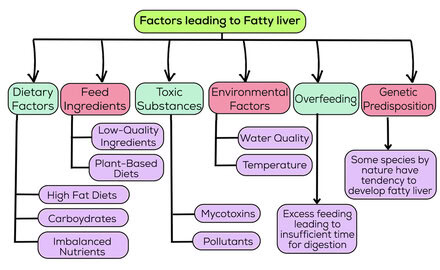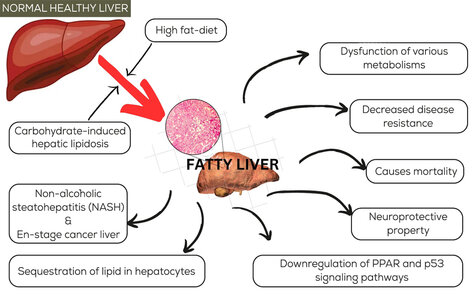The article highlights the significant occurrence of fatty liver disease in aquaculture. It is caused in fish consuming a high-fat diet, resulting in increased oxidative stress, lowered AST and ALT indices, and ultimately leading to mortality. Therefore, to mitigate this, administrating a combination of sorbitol and tri-choline may offer an alternate potential remedy.

TNJFU-Institute of Fisheries Post Graduate Studies, Chennai

TNJFU-Institute of Fisheries Post Graduate Studies, Chennai
AN INTRODUCTION TO FATTY LIVER DISEASE IN FISH
Fatty liver disease in fish, also known as hepatic steatosis, is a condition where excessive fat accumulates in the liver cells of the fish. The ubiquity of the fatty liver (non-alcoholic, called shortly as NAFLD) is amplifying globally in coordination with metabolic syndrome. Due to this issue, non-alcoholic steatohepatitis (NASH), the progressive form of NAFLD, is anticipated to emerge as the escalating problem in causing en-stage cancer liver disease in the Imminent future.
In recent times, Aquaculture reports fatty liver has increased. Fatty liver injury in cultured fish is mainly caused by a high-fat diet, as reported by Du Zhenyu (2014). Studies by Luo et al. (2010) and Kim et al. (2006) have shown that this injury results in metabolic dysfunctions, reduced disease resistance, and mortality in cultured fish. As a result, researchers are now focusing on investigating and resolving this issue further. Incorporating higher levels of lipids may lead to “fatty liver,” while excessive carbohydrates may cause “carbohydrate-induced hepatic lipidosis,” both negatively affecting the liver. To attenuate this, beneficial food like oily fish contains enhanced PUFA content; caffeine and diterpenes in coffee; nuts consisting of MUFA, PUFA, and phenolic acid; flavonol glycosides and catechins in tea. However, in the following section, the use of a nutraceutical to attenuate fatty liver disease is discussed.

SOURCES OR INGREDIENTS
THAT LEAD TO FATTY LIVER
DISEASE
Fatty liver is caused due to various factors. The sequestration of the fat in the liver is caused mainly due to the disruption in the liver metabolism. This metabolic disruption is majorly caused due to the higher inclusion of carbohydrates and fat in the diets, in the case of fish. Formulating a diet of fish with carbohydrate such as the Non-starch Polysaccharide (NSP) and sugars which produces high glucose in the fish blood for a certain period and then are sent to the liver for storage as glycogen. Lipids in the form of Crude lipids account for fat content in the diet. The source or ingredient of lipid which has saturated long-chain fatty acid is metabolized and stored in the liver. So, providing short-chain, medium-chain, PUFA, or HUFA helps in lowering the probability of fish liver affected by that disease. Studies have shown that Omega 3 and omega 6 fatty acids help in the efficient curing of fatty liver in fish.
Other factors such as mycotoxins, pollutants, and environmental parameters are the secondary factors contributing to the manifestation of the disease. These accelerate or kindle the manifestation of the fatty liver.
COMPLICATIONS DUE TO FATTY LIVER DISEASE
In fish, dysfunctional PPAR and p53 signaling pathways cause lipid accumulation in hepatocytes. Functional foods mentioned above improve pathway signaling and liver health. Kuwashiro, et al., (2011) found that telmisartan, a drug, ameliorates NASH in medaka by reducing macrophage infiltration into the liver. Liver damage indicators, GPT and GOT, increase when fish are fed a high-fat diet. Chen et al., (2016) studied liver damage in blunt snout bream (Megalobrama amblycephala). In tilapia, a high-fat diet obstructs lipid metabolism, increases lipid peroxidation, and negatively affects liver health. Previous studies in tilapia show metabolic dysfunctions, oxidative stress, and compromised immune capacity. In 1976, Bang, Dyerberg, and Hjørne discovered that polyunsaturated fatty acids (PUFAs) can decrease serum lipid levels. Omega 3 and omega 6 fatty acids have been found to prevent cardiovascular diseases by reducing lipid accumulation, enhancing insulin sensitivity, and displaying anti-inflammatory properties, as supported by various studies in the literature. These fatty acids also positively impact liver enzyme activity, such as ALT and AST.
There are two customary indicators of liver damage viz, GPT (glutamate pyruvate transaminase) and GOT (glutamate oxalate transaminase) when fish is fed with a high-fat diet. The extent of the liver damage was studied in blunt snout bream (Megalobrama amblycephala) by Chen et al., (2016). In tilapia, it was observed that a high-fat diet obstructed lipid metabolism boosted lipid peroxidation, and led to poor health of the liver. In addition, previous studies in tilapia demonstrate metabolic dysfunctions, oxidative stress, and thereby compromised immune capacity.

HOW SORBITOL AND TRICHOLINE CAN MITIGATE FATTY LIVER DISEASE IN FISH?
In humans, sorbitol and tricholine act as cholesterol-reducing agent. Tricholine in the form of Tricholine citrate and sorbitol. They also help in lowering the toxicity in the liver caused by exposure to drugs. In this combination, the tri-choline acetate act as a bile acid binding agent while sorbitol works as a laxative to the body. Sorbitol is a natural sweetener (sugar alcohol) present in various fruits and nuts especially in the prunes. They are diuretic and cathartic in humans. Furthermore, since tri-choline acts as a bile acid binding agent, they eliminate excess bile acid from the body enforcing the liver in the utilization of cholesterol present in the body. Thus, by this mechanism, the cholesterol in the body is expended. In addition, the improvement in choline deficiency led to decreased occurrence of fatty liver.
CONCLUSION
In accordance with the above studies, it can be inferred that fatty liver disease is of importance in the aquaculture industry, especially in fish species like tilapia. So, to attenuate this liver injury, the combination of sorbitol and tri-choline may be a new course of action to overcome the hurdle of fatty liver disease in aquaculture.
References
1. Gupta, V., Mah, X. J., Garcia, M. C., Antonypillai, C., & van der Poorten, D. (2015). Oily fish, coffee and walnuts: Dietary treatment for nonalcoholic fatty liver disease. World Journal of Gastroenterology: WJG, 21(37), 10621.
2. Parker, H. M., Johnson, N. A., Burdon, C. A., Cohn, J. S., O’Connor, H. T., & George, J. (2012). Omega-3 supplementation and non-alcoholic fatty liver disease: a systematic review and meta-analysis. Journal of hepatology, 56(4), 944-951.
3. Huang, L., Cheng, Y., Huang, K., Zhou, Y., Ma, Y., & Zhang, M. (2018). Ameliorative effect of Sedum sarmentosum Bunge extract on Tilapia fatty liver via the PPAR and P53 signaling pathway. Scientific reports, 8(1), 1-11.
4. Yan, J. et al. Dietary Lipid Levels Influence Lipid Deposition in the Liver of Large Yellow Croaker (Larimichthys crocea) by Regulating Lipoprotein Receptors, Fatty Acid Uptake and Triacylglycerol Synthesis and Catabolism at the Transcriptional Level. PLoS One 10, e0129937, (2015).
5. Kuwashiro, S. et al. Telmisartan improves nonalcoholic steatohepatitis in medaka (Oryzias latipes) by reducing macrophage infltration and fat accumulation. Cell Tissue Res 344, 125–134, (2011).
6. K.D. Kim, K.M. Kim, K.W. Kim, J.K. Yong, S.M. Lee, Inflfluence of lipid level and supplemental lecithin in diet on growth, feed utilization and body composition of juvenile flflounder ( Paralichthys olivaceus ) in suboptimal water temperatures, Aquaculture 251 (2006) 484–490.
7. X.-F. Cao, Y.-J. Dai, M.-Y. Liu, X.-Y. Yuan, C.-C. Wang, Y.-Y. Huang, W.-B. Liu, G.- Z. Jiang, High-fat diet induces aberrant hepatic lipid secretion in blunt snout bream by activating endoplasmic reticulum stress-associated IRE1/XBP1 pathway, Biochim. Biophys. Acta Mol. Cell Biol. Lipids 1864 (2019) 213–223.
8. Zhao, H., Wu, Z., Zhou, Y., Guo, D., Wang, H., & Chen, X. (2019). Hepatic lipid metabolism and oxidative stress responses of grass carp (Ctenopharyngodon idella) fed diets of two different lipid levels against Aeromonas hydrophila infection. Aquaculture, 509, 149-158.
9. Du Zhenyu. (2014). Causes of fatty liver in farmed fish: a review and new perspectives. jfc, 38(9), 1628-1638.
10. Jia, R., Cao, L. P., Du, J. L., He, Q., Gu, Z. Y., Jeney, G., … & Yin, G. J. (2020). Effects of high-fat diet on antioxidative status, apoptosis and inflammation in liver of tilapia (Oreochromis niloticus) via Nrf2, TLRs and JNK pathways. Fish & shellfish immunology, 104, 391-401.
11. Tao, Y. F., Qiang, J., Bao, J. W., Chen, D. J., Yin, G. J., Xu, P., & Zhu, H. J. (2018). Changes in physiological parameters, lipid metabolism, and expression of microRNAs in genetically improved farmed tilapia (Oreochromis niloticus) with fatty liver induced by a high-fat diet. Frontiers in Physiology, 9, 1521
12. Xu, F., Xu, C., Xiao, S., Lu, M., Limbu, S. M., Wang, X., … & Chen, L. (2019). Effects of α‐lipoic acid on growth performance, body composition, antioxidant profile and lipid metabolism of the GIFT tilapia (Oreochromis niloticus) fed high‐fat diets. Aquaculture nutrition, 25(3), 585-596.
13. Lin, J. J., Liu, Y. C., Chang, C. J., Pan, M. H., Lee, M. F., & Pan, B. S. (2018). Hepatoprotective mechanism of freshwater clam extract alleviates non-alcoholic fatty liver disease: elucidated in vitro and in vivo models. Food & function, 9(12), 6315-6325.
14. Faruqui, A. A., Joshi, C., Siddique, W., & Mahajan, R. Evaluation of Efficacy & Tolerability of Trisoliv® Syrup (Andrographolides+ Tricholine Citrate+ Sorbitol) in the Management of Various Liver Dysfunctions.
15. Ghoshal AK, Farber E. Choline deficiency lipotrope deficiency and the development of liver disease including liver cancer: a new perspective. Laboratory Investigation 1993, 68(3)255-60.
About Kavitha Malarvizhi
Kavitha Malarvizhi is a post graduate research scholar working in the area of fish nutrition and feed technology at TNJFU-Institute of Fisheries Post Graduate Studies, Tamil Nadu Dr. J. Jayalalithaa Fisheries University Chennai, Tamil Nadu, India.About Dr. Amit Ranjan
Dr. Amit Ranjan is an Assistant Professor in the Department of Fish Nutrition & Feed Technology at the Institute of Fisheries Post Graduate Studies of Tamil Nadu Dr. J. Jayalalithaa Fisheries University (TNJFU), India. His research focus is on fish and shrimp nutrition, where he conducts both strategic and applied research. With his extensive experience in the commercial culture of shrimp and freshwater fish, he has published several research papers in international peer-reviewed journals and serves as a reviewer for over 50 international peer-reviewed journals.